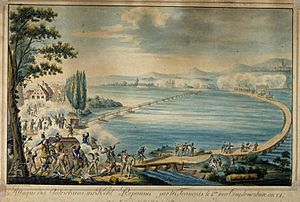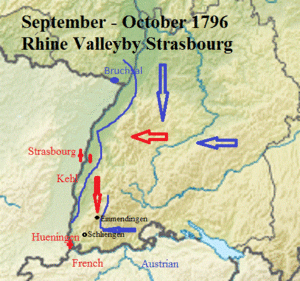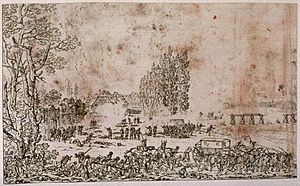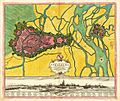Second Battle of Kehl (1796) facts for kids
Quick facts for kids Second Battle of Kehl |
|||||||
|---|---|---|---|---|---|---|---|
| Part of the War of the First Coalition | |||||||
 The Austrians initially pushed out the French defenders, but a strong counter-attack forced them to retreat, leaving the French in possession of the village and the important bridgeheads crossing the Rhine River. |
|||||||
|
|||||||
| Belligerents | |||||||
| Commanders and leaders | |||||||
| Strength | |||||||
| 7,000 | 5,000 | ||||||
| Casualties and losses | |||||||
| 1,200 killed and wounded, 800 captured | 2,000 killed, wounded and missing | ||||||
The Second Battle of Kehl happened on September 18, 1796. During this battle, Austrian and Imperial troops, led by General Franz Petrasch, attacked a French-controlled area near the Rhine river. This area was important because it had bridges that connected the village of Kehl to the city of Strasbourg.
Kehl is now in Germany, but back then it was part of a different region. Strasbourg, across the river, was a French stronghold. This battle was part of the Rhine Campaign of 1796, which was a big part of the French Revolutionary Wars. These wars involved France fighting against many other European countries.
The Rhine river in the 1790s was wild and hard to cross. It had many channels and islands. A system of bridges and forts connected Kehl with Strasbourg. These had been built long ago to help control who could cross the river. The crossings here were very important for France. If they controlled them, their armies could move easily into southwestern Germany.
In late 1796, the Austrian army had taken back much of the land they lost to France earlier that year. On September 18, the Austrians briefly took control of the bridgeheads at Kehl. But a strong French counter-attack forced them to leave. The French kept control of the bridges, but the Austrians controlled the land around them. This situation lasted for a while. Because the Austrians held the surrounding land, the French army couldn't easily cross the Rhine to safety in Strasbourg. This forced the French commander, Jean Victor Marie Moreau, to move his troops south.
Contents
Why This Battle Happened: The 1796 Campaign
The 1796 campaign was part of the larger French Revolutionary Wars. In these wars, France fought against a group of countries called the Coalition. This group included Austria, Prussia, Britain, and others. At first, France won many battles. But by 1795, things were not going as well.
However, the Coalition countries often disagreed on their goals. This made it hard for them to work together. French victories in Italy in 1794 and 1795 made France excited about the war again. It also forced the Coalition to pull back into Central Europe. A truce (a temporary stop to fighting) between Austria and France ended on May 31, 1796.
The Austrian army had many soldiers. One part, the Army of the Lower Rhine, had 90,000 troops. Another part, the Army of the Upper Rhine, had 80,000 troops. Their plan was to attack French armies one by one. But after Napoleon Bonaparte started winning battles in Italy, the Austrian commander, Archduke Charles, was told to hold his ground.
On the French side, the Army of Sambre-et-Meuse had 80,000 soldiers. The Army of the Rhine and Moselle also had many troops. The French plan was to attack in the spring. Two armies would push against the Coalition armies in Germany. A third army would move towards Vienna through Italy.
The French general Jean-Baptiste Jourdan moved his army south. This made the Austrians move their troops to meet him. Then, General Moreau's army quickly marched south and attacked the bridgehead at Kehl. This area was guarded by 7,000 inexperienced troops. They held the bridge for a few hours but then retreated. Moreau's troops then poured into the area. In the south, another French column moved quickly across the river. Archduke Charles became worried about his supply lines and began to retreat.
In August, the Austrian armies joined together and started winning against the French. Jourdan's army was defeated in several battles. This allowed Archduke Charles to send more troops south. It also took Jourdan's army out of the fight for the rest of the campaign.
Before the Main Attack: Skirmishes Near Kehl
While the main armies were moving around, General Franz Petrasch's Austrian troops fought with French forces near a town called Bruchsal. The French troops there were led by General Marc Amand Élisée Scherb. He realized his small force couldn't stop a big Austrian attack. So, he pulled back towards Kehl to protect the important Rhine crossing to Strasbourg. General Moreau's army would need this crossing to get back to France safely.
The Austrians attacked the French at Bruchsal. The French fought back bravely. For two days, the Austrians fought small battles with the French. They were trying to hide their real plan: to go around Bruchsal and march south to take the crossing to Strasbourg. General Scherb found out about this and moved his troops south. He found the Austrians already in a village south of Bruchsal.
General Petrasch sent two battalions to occupy Renchen, which was about 10 kilometers (6 miles) from Kehl. This stopped Moreau's reinforcements from reaching Kehl. It also trapped General Scherb's troops. The small French force at Kehl was left to defend itself.
Kehl's Defenders: September 16-17
The French troops defending Kehl were not very strong. They had one battalion and some smaller groups, led by General Balthazar Alexis Henri Schauenburg. This was too few soldiers to defend such an important place. Moreau reported that some of Scherb's troops arrived, but it's not clear how many. Also, the local people didn't help much, and the soldiers were tired. This meant they couldn't quickly make the forts stronger.
On the evening of September 16, Petrasch and most of his troops arrived near Kehl. By September 17, a small group of Austrians attacked the French guards. This was just a warm-up for the bigger battle the next day.
The Battle on September 18
Before dawn on September 18 (at 3:45 AM), three Austrian groups attacked Kehl. Another group kept General Scherb's forces busy. The main Austrian group crossed the Kinzig river and moved towards the Rhine. They used the river banks for cover. With help from local farmers, they got close to Kehl and entered a narrow path.
The second Austrian group went through a small village called Sundheim towards Kehl. They took control of the village itself, but not the main bridge to Strasbourg. The third group made a fake attack on the other side of the river. Other Austrian troops moved forward to support the main attack.
The Austrians quickly took control of the town's defenses, the village, and the fort. Their soldiers reached one side of an old bridge. They stopped there, almost in sight of the French guards. It's not clear why they stopped. Maybe they thought they had reached the main bridge. But they didn't burn the bridge. Instead, some soldiers started looting and drinking. The French cavalry tried to retreat into Kehl, but many were killed by heavy Austrian fire.
The French tried several times to get the bridges back. One French group was pushed back three times by the larger Austrian force and their cannons. Finally, at 7:00 PM, things started to go better for the French. An Austrian colonel and 200 men were captured inside the fort. The next in command was badly wounded, leaving no one in charge of that Austrian regiment.
The French general Schauenburg had gone to Strasbourg for more troops. He came back with reinforcements, including some local guards. They crossed the bridges and faced a strong Austrian attack. But they were strong enough to fight back. By 10:00 PM, the Austrians still held some parts of the village. A fresh Austrian battalion arrived and attacked again, but they were pushed back. In the end, the Austrians didn't have enough fresh troops to fight against the new French soldiers from Strasbourg. By 11:00 PM, the French had taken back all of Kehl and its defenses.
The Austrians lost about 1,500 to 2,000 men (killed, wounded, or missing). They also had about 300 prisoners. The French lost about 300 killed and 800 wounded, with 800 captured.
What Happened Next
Even though the Austrians didn't fully win, this battle had a big effect on the main armies. General Moreau's French army was moving through the Black Forest mountains to the east. By controlling the eastern side of the Kehl/Strasbourg crossing, the Austrians forced Moreau to march south. This meant any retreat into France would have to happen at the bridges near Hüningen, which was a much longer march.
The main armies met again on October 19 at a battle in the Elz valley. They fought again at Schliengen on October 24. Moreau's army was in a good position on high ground. Archduke Charles attacked both sides of the French army. The French fought hard but eventually had to pull back. Because they couldn't use the Kehl crossing, Moreau had to retreat south to Hüningen.
With a strong group of soldiers protecting his rear, Moreau left his position that night. He retreated about 15.6 kilometers (9.7 miles) to Hüningen. By November 3, he reached Haltingen, where he prepared his army to cross the bridges into France. Archduke Charles then sent most of his army north to begin a long siege of Kehl.
Troops in the Battle
Here are some of the troops who fought in the battle at Kehl:
French Forces
- 24th Demi-brigade de Ligne (one battalion)
- 68th Demi-brigade de Ligne (three battalions)
- 104th Demi-brigade de Ligne (parts of it)
- 19th Dragoon Regiment (two squadrons)
Austrian Forces
- Infantry Regiment Nr. 12 (three battalions)
- Infantry Regiment Nr. 15 (three battalions)
- Infantry Regiment Nr. 38 (parts of it)
Images for kids




